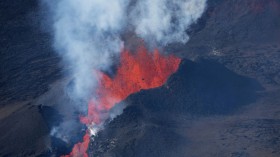A lawsuit filed Monday accuses the US Navy and the National Marine Fisheries Services of violating the Marine Mammal Protection act by their role in allowing a series of planned underwater activities including open-sea bombing drills and sonar activities that, by the Navy's own account, will affect millions of marine mammals.
Dolphins, whales and other marine mammals that depend on sonar and echolocation to find food and navigate, will be in the crosshairs of a five-year naval exercise in the waters between Southern California and Hawaii.
The lawsuit, which was filed by the influential non-profit group National Resources Defense Council (NRDC) and several conservation organizations, says that the federal government, via the National Marine Fisheries Services, illegally granted the Navy permission to harm marine mammals during its ongoing underwater sonar and explosives training activities, which are scheduled to take place until 2018.
Compared to similar activities done in the previous five years, the Navy plans to increase its sonar training activities by 1,100 percent between now and 2018, the NRDC reported, citing a National Marine Fisheries Services ruling allowing the increase activity.
Michael Jasny, the director of the NRDC marine mammal protection project, said the Navy's activities over the next five years will not be sustainable and will harm marine mammals approximately 9.6 million times.
"The science proving the link between sonar exposure and population decline is mounting. And so are the solutions that could prevent thousands of needless injuries and hundreds of deaths," Jasny said in a statement. "There are more than 35 species of whales and dolphins that make Southern California and Hawaiian waters their home, including endangered blue whales, fin whales and hearing-sensitive beaked whales. All are at risk from this preventable harm."
In August of 2013, the Navy's own environmental impact surveys reported that millions of animals would be affected by its underwater sonar training, underwater detonations, and gunnery exercises.
While it only projected 155 marine mammal moralities for its operations off the coast of Hawaii and Southern California, the Navy estimated 2,000 marine mammals would suffer permanent hearing loss or other permanent injury and millions of marine mammals with temporary hearing loss.
"The Navy's analysis indicates that while large numbers of marine mammals may be affected by sonar and explosives activities, over 99.9 percent of the animals affected will experience only temporary behavioral effects that do not result in injury," Rear Adm. Kevin Slates, the energy and environmental readiness division director for the Navy, said in a statement made in August.
At the time, Slate said that live training exercises were necessary to prepare for real-life situations.
"The Navy will operate its most powerful sonar systems for nearly 60,000 hours over the next five years, more than triple the number of hours it was authorized to use these systems in the last five years," the lawsuit against the Navy states. "There is no dispute that the Navy's use of mid-frequency sonar can kill, injure, and disturb marine mammals. Both the Service and the Navy acknowledge that the use of mid-frequency sonar during Navy exercises has contributed to mass strandings of whales and other marine mammals. During the next five years, the Navy will also detonate more tha 250,000 explosives. At least 7,000 of these detonations will be more powerful than the charge that killed at least three dolphins during a Navy training exercise in southern California in 2011."
Blue whales and beaked whale will fall victim to the training exercises. Beaked whales are a deep-diving species that are not well understood by science, and blue whales can grow to be the largest living creatures on Earth.
The death of up to 10 beaked whales and as many as 13 blue whales is authorized for the Navy's five-year operation.
"This is an unprecedented level of harm," Zak Smith, an attorney with the NRDC, told the Los Angeles Times. "In order to authorize these impacts on marine mammals, the service had to turn its back on the best available science."
The lawsuit states that blue whale populations have not increased off the western North America coast in the last two decades and that the military exercises "may pose significant risks to the recovery rates of endangered blue whale populations."
"The sonar will also threaten the western gray whale, one of the most endangered whales in the world," said Doug Norlen of Pacific Environment, a California-based non-profit and plaintiff in the case against the federal government. "With a population of only about 150 individuals, including 30 females of calving age, any injuries or deaths would be devastating. Surely the Navy can find a way to protect our seas without killing its wildlife."
The lawsuit challenges the National Marine Fisheries Services' authorization of "takes" during the naval operation, as well as the supposition that the Navy's activities will not jeopardize the recovery of the blue whale. It asks that the the authorization to voided and that the Navy be forced to comply state and federal environmental laws and that the training be restricted to certain times and locations.
© 2024 NatureWorldNews.com All rights reserved. Do not reproduce without permission.





